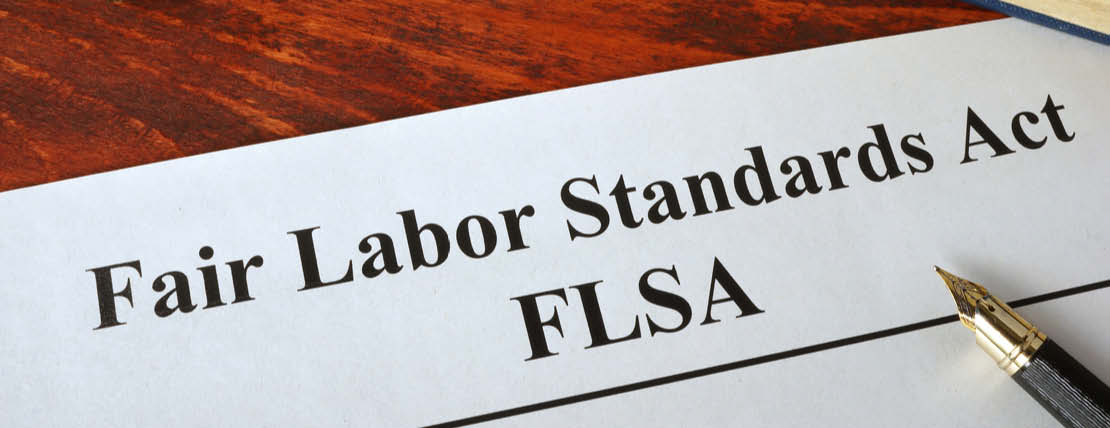For WorldatWork Members
- Guidance on How to Avoid Common FLSA Classification Errors, Workspan Daily Plus+ article
- Are You Aware of These Free DOL Employment Law Resources? Workspan Daily Plus+ article
- Deduction Reasoning: Are You Applying This Part of the FLSA Correctly? Workspan Daily Plus+ article
- FLSA Implementation Toolkit, tool
- FLSA Research, research
For Everyone
- Wage-and-Hour Compliance: You Are Either Fine or Fined, Workspan Daily article
- DOL Outlines Self-Audit Programs to Comply with FLSA, FMLA and More, Workspan Daily article
- Must Incentives Be Included in Hourly Workers’ Regular Rate for OT? Workspan Daily article
- The Facts on Tax: Breaking Down the H.R. 1 Overtime, Tips Provisions, Workspan Daily article
- Sharing Salary Data: When Is It Safe vs. Criminal, on-demand webinar
The Fair Labor Standards Act (FLSA) is a comprehensive and voluminous United States federal law, spanning 64 pages (and nearly 25,000 words) and providing detailed information on antecedent context, formulative findings, definitions, mandated standards, anticipated results, penalties for noncompliance and more.
This article is meant to serve as a primer for total rewards (TR) professionals to help them and their organizations better understand and comply with this law. For experienced TR practitioners, this may be a bit of a refresher. For newer practitioners, this may provide structure and depth to your knowledge of the subject.
Access an additional Workspan Daily article on this subject:
Access a bonus Workspan Daily article on this subject:
The Basis and the Expectation
The Fair Labor Standards Act was signed into law by President Franklin D. Roosevelt on June 25, 1938, with an effective date of Oct. 24, 1938. The landmark legislation included several labor-related provisions, including:
- The establishment of a minimum wage;
- The right to overtime pay for certain individuals working more than 40 hours a week; and,
- Restrictions on the use of child labor.
“[America should be able to give] all able-bodied working men and women a fair day’s pay for a fair day’s work,” Roosevelt stated in a message to Congress prior to the law’s passage. “A self-supporting and self-respecting democracy can plead no justification for the existence of child labor, no economic reason for chiseling worker’s wages or stretching workers’ hours."
Since its inception, the FLSA has covered most, but not all, private- and public-sector employees. Today, more than 143 million American workers are covered by the law, which is enforced by the Wage and Hour Division of the U.S. Department of Labor (DOL).
Who isn’t “covered”?
For an employer to be exempt, it generally must be an entity that:
- Has fewer than two employees; or,
- Doesn’t engage in interstate commerce and has less than $500,000 in annual revenue.
For an employee to be exempt, that person must meet specific salary-basis and duties tests for:
- Executive, administrative or professional (EAP, or otherwise known as “white collar”) employees;
- Outside sales or computer employees; and/or
- Certain highly compensated employees.
To be considered exempt, employees must:
- Be paid a salary that meets the DOL’s salary-level requirements;
- Be paid on a salary basis; and,
- Have primary job duties that fit one of the exemption categories.
The Minimum Wage Component
The FLSA requires employers to pay covered, nonexempt employees at least the minimum wage. In 2007, the basic federal minimum wage was increased, in steps, from $5.15 to $7.25 an hour. The basic minimum wage of $7.25 an hour became fully effective on July 24, 2009.
While legislation has been frequently introduced in the House of Representatives and the Senate (typically by Democratic members) to increase the federal minimum wage beyond $7.25 to offset inflation and the rising cost of living, these bills have stalled. Thus, various states have moved the issue forward. Thirty states (plus the District of Columbia) have minimum wage rates that exceed the federal standard as of Oct. 1, 2025. Twenty-one states and 50 cities and counties adjusted their minimum wage rates at the start of 2025. When federal and state (or local) laws differ, the rule that provides the higher minimum wage to the worker applies.
Employees in jobs that are historically and typically eligible to receive tips from customers may be paid less than the basic minimum wage. However, these workers’ cash wage plus tips must equal at least the $7.25 basic minimum wage. Various states have their own minimum wage rate and maximum tip credit, thus equating to a total tipped minimum wage rate. Check out this Workspan Daily article for details.
If conditions are met, employers also may pay special subminimum wages to:
- Workers with certain disabilities;
- Student learners employed as part of a vocational training program; and,
- Full-time students employed in retail or service establishments, agriculture, or institutions of higher education.
The Overtime Component
Unless classified as exempt, FLSA-covered employees must receive overtime pay for hours worked in excess of 40 in a workweek at a rate not less than one-and-a-half times their regular pay rate. Under the law, there isn’t a limit on the number of hours employees aged 16 and older may work in a workweek. It also doesn’t require overtime pay for work on Saturdays, Sundays, holidays or regular rest days, unless (of course) actual overtime is triggered when working on such days.
The standards apply on a workweek basis — deemed by the DOL as a fixed and regularly recurring period of 168 hours (seven consecutive 24-hour periods). It doesn’t have to coincide with the calendar week — it may begin on any day and at any hour of the day. Different workweeks may be established for different employees or groups of employees. Averaging of hours over two or more weeks isn’t permitted. In general, overtime pay earned in a particular workweek must be paid on the regular pay day for the pay period in which the wages were earned.
The overtime stipulations also allow covered, nonexempt state and local government employees to receive compensatory time off (also known as “comp time”) for hours worked in excess of 40 in a workweek. Comp time is time off with pay in lieu of overtime pay.
The Child Labor Component
The FLSA prohibits the employment of “oppressive child labor” in the U.S. To that end, the act sets a general minimum age of:
- 16 years for employment in nonhazardous occupations; and,
- 18 years for employment in any occupation determined by the DOL’s Secretary of Labor to be hazardous to the health or well-being of minors.
As a caveat, children younger than age 16 may work if certain conditions are met — and the rules for agricultural and nonagricultural jobs vary significantly. For example, the general minimum age for employment in nonhazardous agricultural jobs, outside of school hours, is 14 years.
States may have their own child labor laws with different, and sometimes stricter, rules than what’s included in the FLSA. When federal and state laws differ, the rule that provides the most protection for the minor applies.
Editor’s Note: Additional Content
For more information and resources related to this article, see the pages below, which offer quick access to all WorldatWork content on these topics:
#1 Total Rewards & Comp Newsletter
Subscribe to Workspan Weekly and always get the latest news on compensation and Total Rewards delivered directly to you. Never miss another update on the newest regulations, court decisions, state laws and trends in the field.








